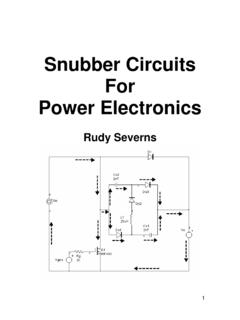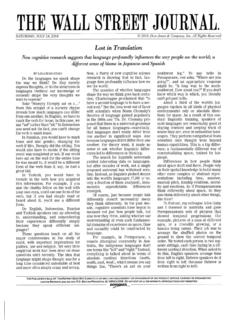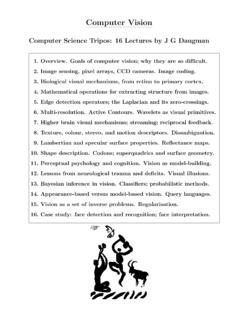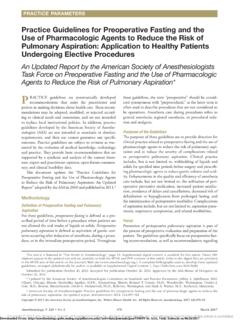Transcription of An Improved Double Extended Zepp - Antennas By N6LF
1 An Improved Double Extended Zepp By Rudy Severns, N6LF. 32857 Fox Lane PO Box 589. Cottage Grove, OR 97424. This article was orinally published in the ARRL Antenna Compendium Vol. 4 1995. T. he sunspot cycle is headed down and the low bands are coming to life for DXing. The next several years will N6LF revisits the classic Double be the time to make those low-band contacts for DXCC. As always, the key to low-band Extended Zepp to improve pattern and SWR bandwidth. He also offers operation is a good antenna. Unfortunately for 7 MHz and down, good Antennas don't come in a box ready to assemble. Every lo- cation will have a unique set of limitations and opportunities. some sage advice about computer One very important difference between this sunspot minima and all past ones is the avail- modeling. ability of inexpensive, easy-to-use and pow- erful antenna modeling ,2 This soft- ware allows you to design and optimize an antenna that exactly fits your situation and pocketbook.
2 While cut-and-try experimenta- tion is a very slow way to optimize Antennas , amount of gain over a dipole of approximately modeling is so quick that a wide range of so- 3 dB. The radiation pattern for a DEZepp de- lutions can be investigated easily. The real signed for MHz and suspended 80 feet problem with modeling is generating the will above ground is shown in Fig 1, along with power to stop fooling with the variations and the pattern for a /2 dipole at the same height go out and build something! for comparison. The elevation angle is 26 , the The following article uses 40 and 80/75- peak of the main lobe. The current distribu- meter Double Extended Zepps (DEZepp) as tion along the antenna is shown in Fig 2. examples of what you can accomplish. By The DEZepp does indeed provide gain over adding two small capacitors, made from the dipole, but only over the relatively small short lengths of RG-8, in just the right place, angle of approximately 40.
3 The beamwidth the pattern can be Improved and the driving- between 3 dB points is 35 . Unless the antenna point impedance changed from reactive and is pointed directly toward the receiving sta- narrowband to resistive and wideband. This tion, the gain is not usable due to the narrow allows the antenna to be used without a tuner beam width. In addition to the narrow main and with an SWR < :1 over the entire 40- lobe, there are significant sidelobes. These are meter band, or with SWR < 2:1 over the not big enough to be helpful in those direc - tions, but they will also certainly pick up noise Fig 1 Azimuth pattern of classic entire 75/80-meter band. Double Extended Zepp (solid line) at and interference. The impedance of the an- MHz, compared with standard A Look at the Classical DEZepp tenna is very reactive, and even when matched dipole (dashed line), both 80 feet high The classical DEZepp is simply a piece of at midband does not allow the entire band to over average ground.
4 Patterns are wire long, fed at the center, usually with be covered without retuning. shown at 26 elevation, where the gain is maximum. The wire runs along the open-wire transmission line and a tuner at the For this reason, the DEZepp has tradition- 270 to 90 axis on the graph. Note transmitter. The DEZepp displays a useful ally been used with an antenna tuner. This is significant sidelobes for DEZepp. and therefore less loss. With either choice it is desirable to use as few components as possible. As an initial trial I decided to use only two capacitors, one on each side of the antenna. I. varied the value and position of the capacitors to see what would happen. It quickly became clear that I could tune out the reactance at the feedpoint by adjusting the capacitor value, making the antenna look like a resistor over the entire band. The value of the feed-point resistance could be varied from less than 150 to over 1500 by changing the loca- tion of the capacitors and adjusting their val- Fig 2 Schematic for classic DEZepp, Fig 3 Schematic for modified N6LF ues to resonate the antenna.
5 The AO 6. showing current distribution along DEZepp, with new current distribution. (Antenna Optimizer) software1 has the nice antenna. The bulging out of the Overall length is 170 feet, with pF feature that it will automatically adjust a vari- current in the opposite direction near capacitors placed 25 feet each side of the center of the antenna is responsible center. Now current distribution doesn't able to tune out reactance. Simultaneously, the for the sidelobes seen in Fig 1. create sidelobes. pattern was also changing in useful ways. A number of interesting combinations were created. The one I elected to use is shown in Fig 3. The antenna is 170 feet in length. That is a couple of feet shorter than the classic DEZepp, but that also just happens to be all the distance I had between my supporting trees! Two pF. capacitors are located 25 feet out each side of the center.
6 The antenna is fed with 450- trans- mission line and a 9:1 three-core Guanella balun3 used at the transmitter to convert to 50 . The transmission line can be any convenient length and it operates with a very low SWR. That's all there is to it. The radiation pat- tern, overlaid with that for a standard DEZepp for comparison, is shown in Fig 4. A compari- son to a standard dipole is shown in Fig 5. The sidelobes are now reduced to below 20 dB. The main lobe is now 43 wide at the 3-dB points, Fig 4 Azimuth pattern for N6LF DEZepp Fig 5 Azimuth pattern for N6LF as opposed to 35 for the original DEZepp. The (solid line), compared to classic DEZepp DEZepp (solid line), compared to dipole (dashed line). The main lobe for the (dashed line) at the same height. antenna has gain over a dipole for > 50 now. modified antenna is slightly broader than The gain of the main lobe has dropped only that of the classic model, and the dB below the original DEZepp.
7 Sidelobes are suppressed better. The reason for the pattern change can be seen in Fig 3, showing the modified current distribution. The main current maxima are not a terrible hardship but it would be nice still pretty much in the same place, but the if the tuner could be eliminated, at least on current in the center of the antenna now one band, and a low SWR presented to the flows in the opposite direction. The result- transmitter over a whole band. ing pattern is much cleaner. The gain displayed by the DEZepp is due to the separation between the two current Experimental Results maxima. The small inverted current in the I managed to pry myself away from the com- center section subtracts a little from the main puter and actually build the antenna. It was lobe and contributes to the sidelobes. The made from #14 wire and the capacitors were DEZepp is essentially two end-fed collinear made from sections of RG-213, shown dipoles.
8 The transmission line and the center in Fig 6A. Note that great care should be taken portion of the antenna are the feed system. to seal out moisture in these capacitors. The It would be very beneficial to suppress the voltage across the capacitor for kW will be sidelobes and put that energy into a broader about 2000 V so any corona will quickly de- main lobe, retaining most of the gain if possible. stroy the capacitor. One of the nice features of modeling software is that it gives the current A Modified DEZepp amplitude along the antenna, making it easy to The key to modifying the radiation pattern determine the stresses on any series reactances. Fig 6 Construction details for series is to modify the current distribution. One of the I used silicon sealant and then covered both capacitor made from RG-213 coaxial cable. At A, the method used by N6LF is simplest ways to do this is to insert a ends with coax seal, finally wrapping it with illustrated.
9 At B, a suggested method to seal reactance(s) in series with the wire. This could plastic tape. The solder balls indicated on the capacitor better against weather is shown, either be an inductor(s) or a capacitor(s). In drawing are to prevent wicking of moisture using a section of PVC pipe with end caps. general, a series capacitor will have a higher Q through the braid and the stranded center con- ductor. This is a small but important point if meters. For the bands above 40 meters, how- very helpful with comments on the design, and long service out in the weather is expected. An ever, the reactance of the capacitors drops rap- of course he created the new NEC Wires pro- even better way to protect the capacitor would idly and the behavior is very much the same as gram. An antenna is only as good as the mate- be to enclose it in a short piece of PVC pipe for the normal DEZepp.
10 The price paid for im- rials that go into it. I used the beautiful silky . with end caps, as shown in Fig 6B. proving operation on 40 meters is the loss of 75/ stranded copper-clad steel wire supplied by Note that all RG-8 type cables do not have 80 meters. Similarly, in the 75/80-meter ver- Press Jones, N8UG, and also some of his 450- exactly the same capacitance per foot and there sion, performance on 160 meters is sacrificed. transmission line. It was wonderful to have will also be some end effect adding to the ca- a wire antenna that didn't try to envelop you pacitance. I trimmed the capacitor with a capaci- Some Final Thoughts (and every nearby bush) like a boa constrictor tance meter. It isn't necessary to be too exact The antenna shown here represents a very due to a built-in set in the wire. I checked the effect of varying the capacitance simple modification of an old idea to suit a par- 10% and the antenna still works fine.




